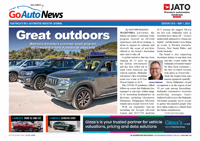Make / Model Search
News - General News - Electric VehiclesDual battery technology the way aheadOur Next Energy’s Gemini battery project is to offer a best of both world’s solution11 May 2023 By MATT BROGAN IT SEEMS American and Australian buyers have a lot in common when it comes to cars. They both love to buy a seven-seat SUV for the family of four. They get utes in case they want to tow something one day. And they buy highly customised four-wheel drives that never leave the black-top.
It is a conundrum noted by Our Next Energy (ONE) CEO, Mujeeb Ijaz, who spoke to Automotive News this week about how buying for edge cases (or ‘what if’ situations) is an issue that applies not just to SUVs, utes and four-wheel drives, but also to electric vehicles.
According to Mr Ijaz, buyers want long range battery capacities in their vehicles, but seldom if at all drive those distances between charging sessions.
He said the costs of such a scenario are part of what makes EVs dearer than their ICE counterparts, not only from a manufacturing standpoint, but also in the context of weight versus energy consumption.
Interestingly – and unlike suggestions proffered by other car and battery executives – Mr Ijaz’s solution is to offer a vehicle with two separate batteries: one that is small and reliable for everyday use and a second, energy-dense unit that provides power for longer trips.
“Our ambition is to have a 600-mile (967km) on a single-charge range so that we can offer customers the capability to adopt electric vehicles for any use case that comes their way – temperature, speed, towing, hill climbing, etcetera,” Mr Ijaz told Automotive News at the recent Advanced Clean Transportation expo in California.
While no manufacturer is yet to offer such technology in production form, Mr Ijaz says ONE has secured funding to pursue the dual-battery strategy, and said he believes the idea beats other long-range battery types (which usually comprise a mixed chemistry of lithium, nickel, manganese and cobalt, or NMC) for one very obvious reason: cost.
According to a recent McKinsey & Co. report, the high-grade nickel and cobalt used in the production of EV batteries is not only expensive, but also raises environmental concerns related to mining and refining of the materials.
There are also geopolitical issues. Almost a third of nickel’s global production comes from China and Russia.
Cobalt is similarly affected. McKinsey & Co. says approximately 70 per cent of the world’s production comes from the Democratic Republic of Congo, which “operates without the safety standards or worker protections” afforded in first-world countries, and allows child labour, according to a report from Institutional Shareholder Services.
Mr Ijaz was also quick to note the other issue surround mixed chemistry batteries – the widely publicised issue of EV battery fires.
“Nickel and cobalt, when paired together, are an oxide chemistry and represent a risk of thermal runaway,” he reiterated.
According to Automotive News, several manufacturers in the United States have already recalled NMC chemistry batteries over the fire risk, including Chevrolet and Hyundai.
Mr Ijaz said the dual-battery projected, called Gemini after the astrological twins, leverages different battery chemistries to achieve lower costs, increased safety and reliability, and to provide the edge-case range consumers seek.
ONE is already reported to be working with BMW to begin field testing an electric iX SUV equipped with the Gemini battery system later this year.  Read more |
Click to shareGeneral News articlesResearch General News Motor industry news |












Facebook Twitter Instagram